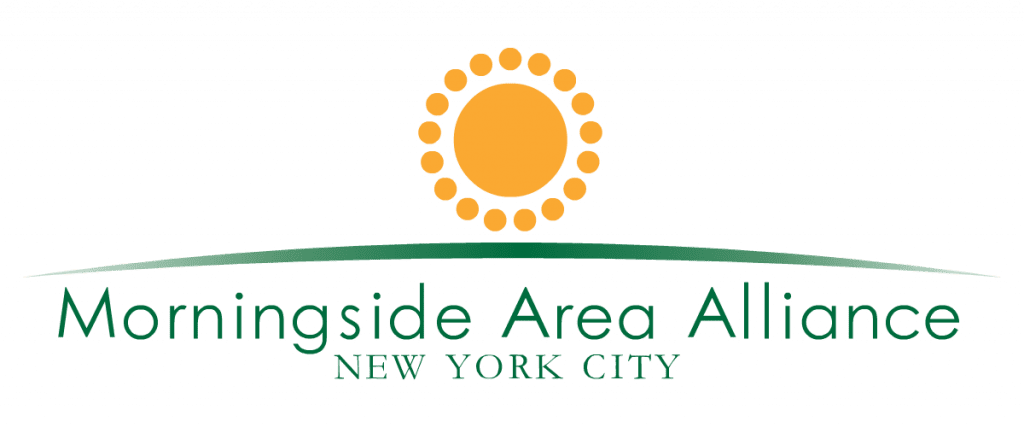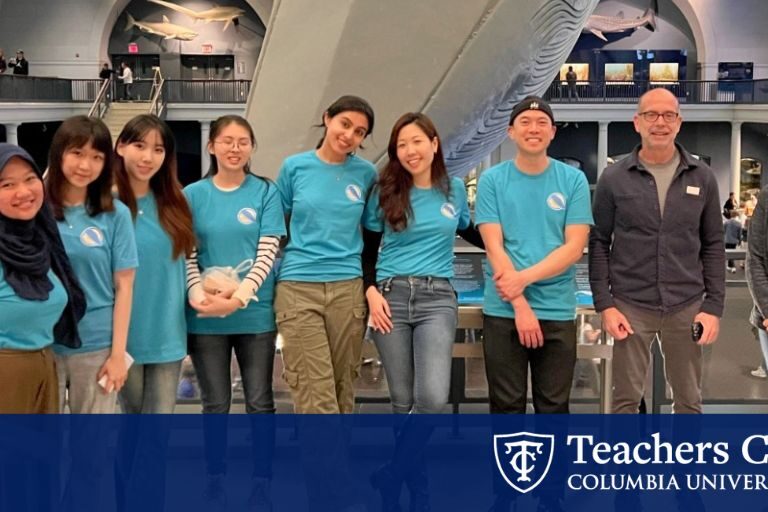Have you ever wondered how marine ecosystems contribute to the carbon cycle or our greater ecosystem? At EarthFest in April, visitors of the American Museum of Natural History (AMNH) learned just that through an immersive augmented learning experience focused on marine life ecosystems and the carbon system, designed by students from TC’s Digital Futures Institute (DFI) Scholars Program and Communication, Media, and Learning Technologies Design (CMLTD) program. “Biodiversity is crucial for maintaining the stability and resilience of ecosystems,” shared TC student Lexin Xiong, who collaborated alongside Marsha Fabiola, Wenjun Yang, and Yuling Zhou. “Programs and educational projects like ours at the museum play a key role in spreading awareness and knowledge about these concepts.”
The initiative was part of a larger collaboration between the American Museum of Natural History, The Brown Institute at Columbia University, Learning the Earth with Artificial Intelligence and Physics (LEAP), and TC’s Digital Futures Institute (DFI). The project is also part of TC’s Public Good Initiative, which aims to address global challenges and increase collaboration across the College.
The featured exhibit, “Carbon Catchers,” an augmented reality scavenger hunt, educated more than 2,000 participants about the importance of conservation in combating climate change. “This project gave visitors, especially families, a room for conversation about carbon that is different from the general narratives, like carbon footprint and consumerism. It allowed new understanding about how carbon naturally takes place in the wildlife, especially under water,” shared Marsha Fabiola, a student who assisted in the project’s coding process.
Visitors were encouraged to stop by the Milstein Hall of Ocean Life to learn about marine animals, like the West Indian Manatee, crucial in reducing carbon in the Earth’s atmosphere. Through five augmented reality dioramas, users explored different oceanic food chains, furthering their understanding of how various species help stabilize the carbon cycle.
Carousel
“Our collaboration with AMNH and the Brown Institute—both renowned leaders in engaging with people from all corners of the world—allows us to bring climate research to new audiences in fun and impactful ways.”
Pierre Gentine, Director of LEAP; Maurice Ewing and J. Lamar Worzel Professor of Geophysics, Departments of Earth and Environmental Engineering and Earth and Environmental Sciences.
“Carbon Catchers” was the museum’s first web-based augmented reality experience. This project brought museum exhibits and science learning to life for thousands of visitors, featuring the stories of marine animals and their roles in carbon capture.”
Eozin Che, Lead Creative Technologist at the American Museum of Natural History
“The AR experiences demonstrate the crucial role these beloved sea creatures play in the Earth’s carbon cycle in a highly engaging way.”
Tian Zheng, LEAP’s Chief Convergence Officer & Education Director and Professor & Chair of the Department of Statistics at Columbia University.
Yet, this is just one of many dynamic educational opportunities students can access at Teachers College through the CMLTD program. “We provide many ways for our students to develop their design skills, specifically in developing research- and practice-informed solutions,” shares TC’s Yoo Kyung Chang. “Apart from taking the classes to set the theoretical foundation, our students engage in opportunities to practice their skills in an authentic context.”
“The DFI Scholars Program is a pathway for TC graduate students to expand their digital imaginations by collaborating with non-profit organizations in and around New York City to leverage digital media and technology for public good. It aims to recruit students from across the College and partner with existing educational programs, while also identifying placements for students outside of existing programs,” adds Lalitha Vasudevan, Vice Dean for Innovation and Professor of Technology and Education. “Students participating in this program have used software, experimented with emerging technologies such as virtual reality and artificial intelligence, and engaged media tools to increase community access to innovative and meaningful experiences.”
(Photo courtesy of Yuling Zhou.)
And for students in the program, the experience was transformative, to say the least. Together, they worked on the project for over ten weeks, facing challenges and triumphs along the way.
“The journey was filled with challenges, yet the collaboration within our team made it a success,” shared student Yuling Zhou, who led the project’s UX/UI design. “As people explored the carbon cycle, the smiles and excitement reinforced the power of AR and gamification in educational settings.”
Many walked away with an even deeper understanding of technological and ecological concepts.
“This project showcased the beauty of edtech and gamification, where curiosity fuels innovation and learning becomes the greatest success,” added student Wenjun Yang. “Witnessing users enjoying and genuinely learning from our work made me realize that perfection isn’t paramount.”
Fabiola shared that the experience has even inspired her to implement the same learning modalities in her home country of Indonesia. “It proves that people can look beyond a museum installation and have a meaningful experience from it—turning museums into places of active learning. Throughout the process, we were thoughtful about the affordance, accessibility, and how to address such issues on different devices.”
(Pictured: Tian Zheng, Professor and Department Chair, Dept. of Statistics at Columbia University; Chief Convergence Officer + Director of Education at LEAP; Eric Chen, Director of Creative Research, Brown Institute for Media Innovation at Columbia University School of Journalism; Molly Lopez, Managing Director, LEAP; Marsha Fabiola, master’s student at Teachers College and AR Developer Intern.) (Photo courtesy of Molly Lopez.)
With the rapid advancement in augmented reality and digital learning, the project serves as a creative prompt for collaborations of similar nature down the road. “It’s a testament to the innovative and creative work that our [CMLTD] students are doing today and what they’ll continue to accomplish in the future,” added Charles Lang, Senior Executive Director of DFI at Teachers College.
“It’s exciting to think about the potential of AR and VR technologies in furthering public education, particularly around science and conservation,” concludes Xiong. “This project brought together technology, ecology, and education to create a unique platform that not only informed but also inspired museum visitors to appreciate the natural world in new ways.”
Published Tuesday, Jun 4, 2024

